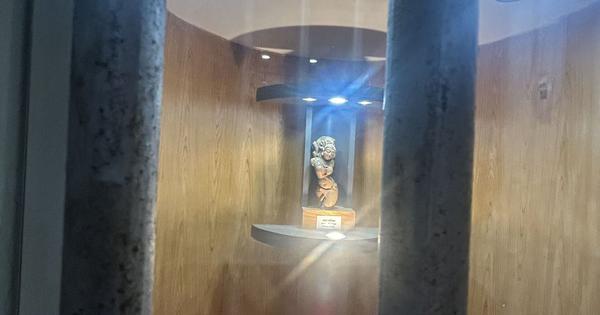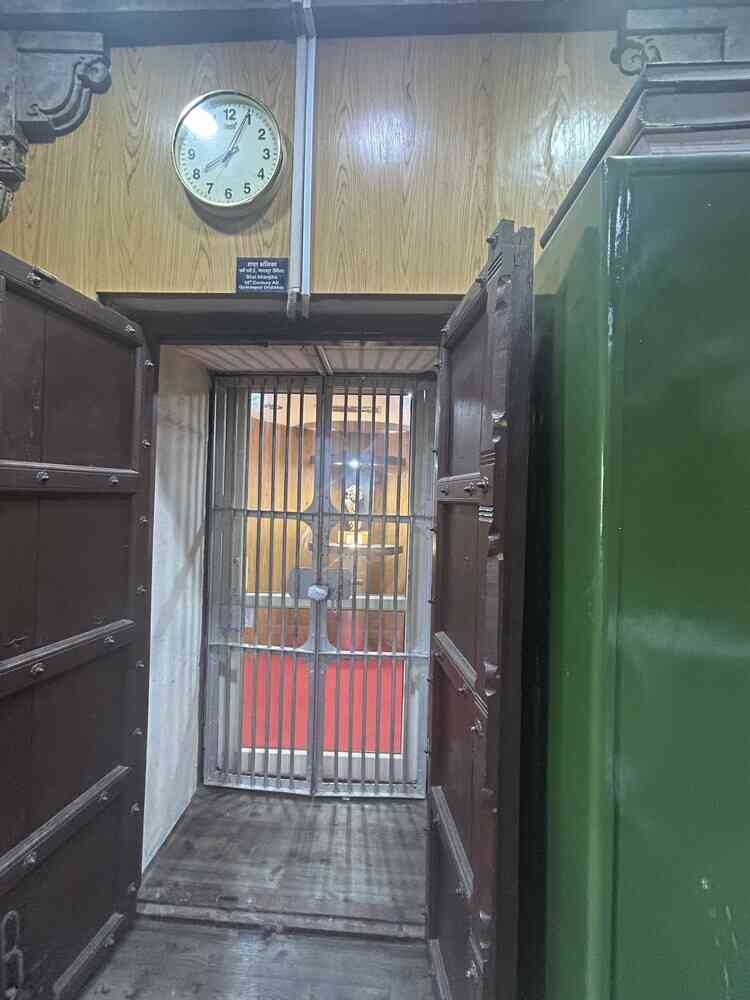
It’s not very often that one sees a deity behind bars. It is a disconcerting experience, straight out of some clumsily-written supernatural fantasy. In the real world, such a sight is on view on the first storey terrace of Gwalior’s Gujari Mahal Archaeological Museum.
In a barred antechamber to the right of the curator’s tube-lit and laminate-walled sarkari office rests a millennium-old nature spirit or yakshi, identified as a “salabhanjika”. Officially dated between the 10th and 11th century CE, the stone sculpture is the armless torso of a voluptuous, richly bejewelled and elaborately coiffed woman. Hip cocked and leg visible through the slit of her antariya, she strikes a graceful tribhanga pose that bends at three points. Behind her inclined head and ornate headpiece are the remnants of branch-like projections jutting out from the relief.
Some of this detail is only discernible through a camera phone since the bars keep visitors too far to see the sculpture’s full relief or walk around her – a frustrating limitation for a work long celebrated as one of the finest interpretations of the feminine form in Indian art, what art historian Ananda Coomaraswamy once called the “woman-and-tree motif, fundamentally characteristic of Indian art”.
Dubbed the Mona Lisa of India by the tourism industry, apparently for her enigmatic smile, the yakshi is locally known as Gyaraspur ki apsara after the site she was discovered at. Gyaraspur is an ancient town in Madhya Pradesh’s Vidisha district, about 350 km south of Gwalior, containing a number of ruins of religious architecture of Buddhist, Jain and Hindu origins. While there is no public chronicle of her excavation, one can surmise that she was probably retrieved during the digs led by Gwalior State archaeologist MB Garde in the 1930s. Social media posts by Madhya Pradesh Tourism posit that she may have been part of one of Gyaraspur’s major structures from the Paramara era – an ornamental swing-evoking entrance arch called the Hindola torana that once led to a temple.
Her precise provenance may be uncertain, but her identity as a salabhanjika offers some context.
The Sanskrit word salabhanjika literally translates to “woman breaking a sala tree”. The figure – a woman standing under a tree and bending its bough with one arm – is an ancient South Asian iconographic type. This explains the triple flexion of the Gwalior yakshi’s upper body, the relatively raised position of the two arm stumps and the hint of the tree behind her.
Flourishing in what is now Madhya Pradesh and produced across the subcontinent from Gandhara to Mathura to Nagarjunakonda, salabhanjikas serve as both architectural elements (sculptural rather than structural, as epigraphist Jean Phillipe Vogel clarifies) and plastic objects. Coomaraswamy identifies three distinct interpretations of the motif: the sacred tableaux of Buddha’s nativity and later medieval Hindu river goddesses, and the secular scenes involving fertility metaphors which thrived throughout. He summarises the varieties, “Sometimes these dryads stand on a yaksha or animal. Sometimes they are adorning themselves with jewels, or using a mirror. Very often they hold with one hand a branch of the tree under which they stand, sometimes one leg is twined round the stem of the tree (an erotic conception, for lata is both “creeper” or “vine,” and “woman”).”
Architecture and literature
In his 1929 essay The Woman and Tree or salabhanjika in Indian Literature and Art, Vogel traces the term salabhanjika to grammarian Panini’s treatise Ashtadhyayi (6th-5th century BCE), in a list of Eastern Indian women’s games, examples illustrating a rule. While there is no description of the game, Vogel deduces through morphological analysis that it involved plucking sala flowers. Over the next 1500 years, up to the 10th century, the word appears often, historian UN Roy contends in his article Salabhanjika Motif in Sanskrit Literature.
Following the insights of both Vogel and Roy, as they navigate various texts from this period, we learn that salabhanjika also referred to a festival or parva, possibly in Magadh, during which sala blossoms were gathered. The term not only signified the game but also the women who participated in it. The most famous among such women was Mahamaya, the Buddha’s mother. It was in the sala wood of Lumbini that she stopped to play the game. Standing cross-legged under the tree, she clasped its branch and commenced labour in the tribhanga position – thus was born the Buddha.

It is precisely within early Buddhist architecture that the salabhanjika transitioned from a game or festival to a representational formula. According to Vogel, the toranas (gateways to enlightenment) of the stupa at Bharhut, dating back to a couple of centuries before the Common Era, feature the earliest proto-salabhanjika pillar figures.
In literature, as Vogel notes, the term debuts in Buddhacarita, Asvaghosa’s early 2nd-century CE poem: Avalambya gavaksapärsvamanya sayita capa-vibhagna-gatrayastih / viraraja vilambicaruhãra racita torana-salabhañjikeva. Vogel’s translation interprets this as a description of women who, having failed to entice the Prince with sensual pleasures, have collapsed into sleep.
Their architectural counterparts connote similar temptations to emphasise the Buddha’s abstention. Roy explains: “These salabhanjika models, representing sensuous beauties, were engraved on the rail-posts of the stupas, and symbolize external allurements and worldly attractions, aversion to which had prompted the Buddha to renounce the pleasures of the palace.” The Gwalior yakshi seems to be just such a torana salabhanjika, broken off from the Hindola arch and mounted in the museum.
By the Gupta period (4th-6th century CE), Roy tells us, the salabhanjika became rare for two reasons: a shift in Buddhist theology that reduced the demand for nativity scene and the parallel recasting of the torana figures with Vedic deities – the river goddesses, Ganga and Yamuna – for whom the sala branch no longer held any religious significance. At a memorial lecture at the Indian Art History Congress in 2010, art historian Devangana Desai contended that by 1000 CE, salabhanjika “was no longer restricted to the Woman-and-Tree image but simply meant a statue of a woman.”
![A Hoysala Empire-era salabhanjika in Belur, Karnataka. Credit: Nithin Bolar K/Wikimedia Commons [CC BY-SA 4.0]. kiwuhgyakk 1759740907](https://sc0.blr1.cdn.digitaloceanspaces.com/inline/kiwuhgyakk-1759740907.jpg)
Roy notes that the word itself continued to appear in Sanskrit literature of the early medieval period, to which the Gwalior salabhanjika belongs. Although by this time the salabhanjika typically appears as a stambha-shirsha on the brackets or capitals of pillars in Hindu and Jain temples, Desai says, this does not seem to be the case of the Gwalior yaksi. She is perhaps an anachronistic torana salabhanjika.
The case for her classification is supported by a note in the 1971 book 5000 Years of Indian Art by art historian Mario Bussagli and India’s then National Museum director Calembus Sivaramamurti: firstly, a similar pose is extant on the side of the Hindola torana and secondly, the sculpture’s superlative quality indicates that it was not merely ornamental, and may have held architectural value.
Fertility deity
Apart from her provenance, the other mystery of the Gwalior salabhanjika is her Mona Lisa smile.
To decipher it, we must turn to the codes of fertility iconography. In her lecture, Desai quotes art historian Vidya Dehejia’s contention that “it would be useful to redefine it [the salabhanjika motif] as making more direct reference to the rite of dohada, whereby the touch of women or contact with them brings trees, plants, and creepers into blossom”. Linking the dohada ritual to the mythography of the dryad, Coomaraswamy defines it as “a pregnancy longing, and the tree is represented as feeling, like a woman, such a longing, nor can its flowers open until it is satisfied”.
Desai catalogues specific dohada rites associated with 10 trees. The most famous one, popularised in Sanskrit literature of the early 1st millennium by writers like Kalidasa, is that for the asoka, which blossoms with a kick from a young woman. The blossom of the mango tree, on the other hand, is prompted by a smile from a woman, or her act of blowing. The expression on the Gwalior salabhanjika’s face could well allude to her ability to make mango trees bloom. The mango, associated with love, was the tree of choice for the Sanchi salabhanjikas many centuries prior. It was also where the 10th-11th century Gwalior salabhanjika’s stambha-shirsha contemporaries stood inside temples. This raises the possibility of that iconography having been retained across the centuries or adapted for sculpting such a belated example of a torana salabhanjika.
![A salabhanjika on the eastern torana at Sanchi. Credit: Vu2sga/Wikimedia Commons [CC BY-SA 3.0]. omxammfzxw 1759741121](https://sc0.blr1.cdn.digitaloceanspaces.com/inline/omxammfzxw-1759741121.jpg)
The Gwalior yaksi’s presence on the entrance arch of the temple underscores its function as a fertility deity. In its incarnation as pregnant Mahamaya giving birth as she holds the tree or the woman causing the pregnant tree to flower and eventually reproduce, the salabhanjika has always connoted life and human-nature synergy. Coomaraswamy observes, “These figures of fertility spirits are present here because the people are here. Women, accustomed to invoke the blessings of a tree spirit, would approach the railing pillar images with similar expectations.” Transplanted from the atmosphere evoked by classical literature and the lyrical animism of ancient folklore, it is hard to imagine the salabhanjika delivering, pun intended, inside the barren premises of the Gujari Mahal Archaeological Museum curator’s office.
Barred none
India’s provincial museums have long struggled with poor display conditions and irresponsible management. Yet imprisoning one of the subcontinent’s most celebrated sculptures seems a new low. The lack of access is compounded by official indifference. When I tried to learn why the yakshi had been placed in a strongroom, I met a wall of bureaucratic deflection.
Learning online that I would need permission to see the Gwalior salabhanjika, I contacted Sapan Sahu, curator of the Gujari Mahal Museum, before heading to Gwalior. He gave me the impression that I would be able to access the room. However, when I arrived, he clarified that they meant merely that I could see her through the bars – which anyone can, thus rendering my seeking of permission unnecessary.
Assuming this was all a result of genuine miscommunication, I asked why she had been placed in a strong room and under what conditions she was permitted visitors. Sahu had no answer. His superior, the museum’s Deputy Director PC Mahobiya, only repeated the phrase “for security purposes” like a 21st-century CE incantation to placate the imprisoned salabhanjika. He directed me to speak to Urmila Shukla, commissioner of Madhya Pradesh’s Archaeological Department in Bhopal, who sent me back to Mahobiya.
![Salabhanjikas at Museo d'Arte Orientale in Turin, Italy. Credit: Sailko/Wikimedia Commons [CC BY-SA 3.0]. wfbaehshae 1759741863](https://sc0.blr1.cdn.digitaloceanspaces.com/inline/wfbaehshae-1759741863.jpg)
Conceding defeat in the face of bureaucratic evasion, I let her know I was going to proceed without their comments. She then called to snap, “What is it that you want? It’s my policy to not give any interviews or comments to the media.” Before hanging up, she mentioned a legendary theft that had prompted such security, but was unable to give any details.
It is hard to say when such a theft would have taken place. Two Gwalioris who were children in the 1960s and ’70s recalled memories of touching a free salabhanjika, suggesting she was not always locked up. One of them speculated that she was jailed after her trip to Paris for the Festival of India 1985-’86 (an Illustrated Weekly of India article from 1987 reports that Gujari Mahal Museum was forced to send their prize artefact). Incidentally, during the next Festival of India in the Soviet Union (1987-’88), two other nature spirits – Patna Museum’s Didarganj Yakshi and Sanchi Museum’s salabhanjika – were damaged in transit. Perhaps fearing a similar mishap, the Gwalior museum sealed its own. Yet, even before the 1980s, a 1977 Museums Conference report noted that she was kept “in a double cupboard – one wooden, another iron”. Her incarceration, going on half a century, predates any known theft – and persists without explanation.
Ironically, the Mona Lisa, to which the Gwalior salabhanjika is often compared, was stolen in 1911 but not punished by being put in jail. Today, of course, she is installed inside a bulletproof glass enclosure that secures without obscuring. Closer home, despite being damaged, the Didarganj Yaksi continues to stand free. Why, then, can the Gujari Mahal Museum not replace the iron bars with a secure glass enclosure? The question hangs unanswered. By denying viewers a full encounter with an exquisite exemplar of one of India’s most unique sculptural forms, the institution does a disservice to both public and heritage alike.
Around the same time as when the Gwalior salabhanjika was made, Somdeva wrote the Kathasaritasagar. Vogel recounts a story from it in which a gambler marries an apsara and follows her into the rain god Indra’s celestial court to watch a dance. Caught bringing her mortal husband to the court, the apsara is cursed by Indra to become imprisoned inside a temple salabhanjika, to be freed only when the temple is demolished. Her intrepid husband disguises himself as an ascetic and tricks the king who built the temple into demolishing it to prevent inauspiciousness. Thus, the apsara was freed.
May the Gyaraspur ki apsara experience such deliverance soon.
Kamayani Sharma is an independent writer, researcher and podcaster based in New Delhi. This project was made possible under the Scroll x MMF Arts Writer Grant.
📰 Crime Today News is proudly sponsored by DRYFRUIT & CO – A Brand by eFabby Global LLC
Design & Developed by Yes Mom Hosting






